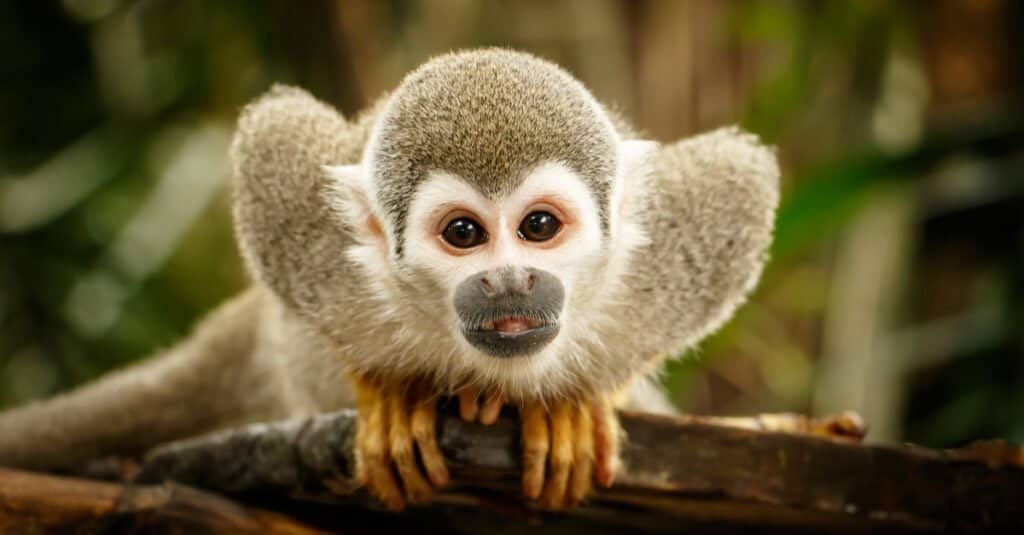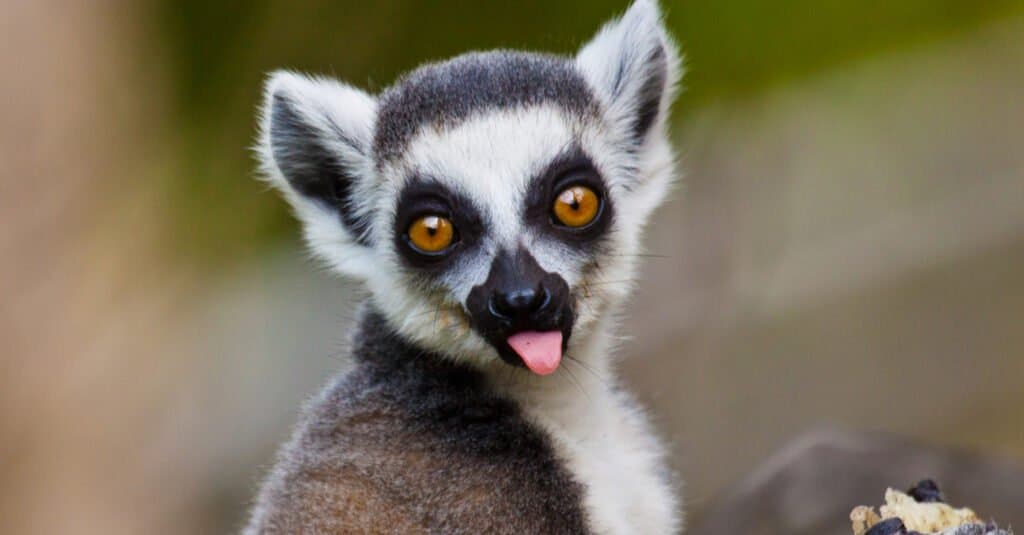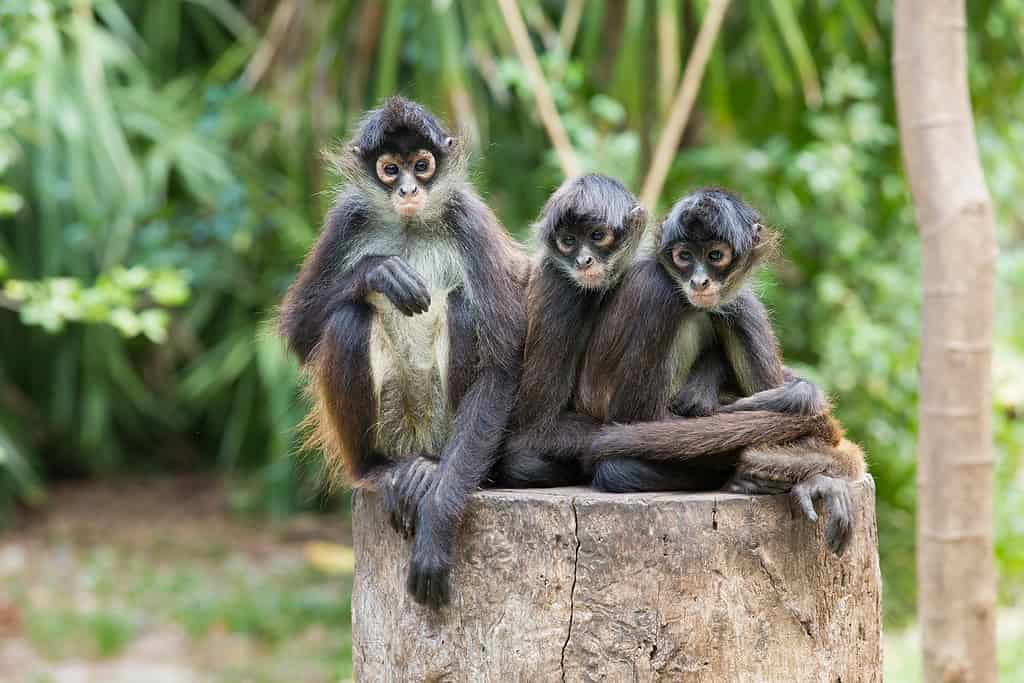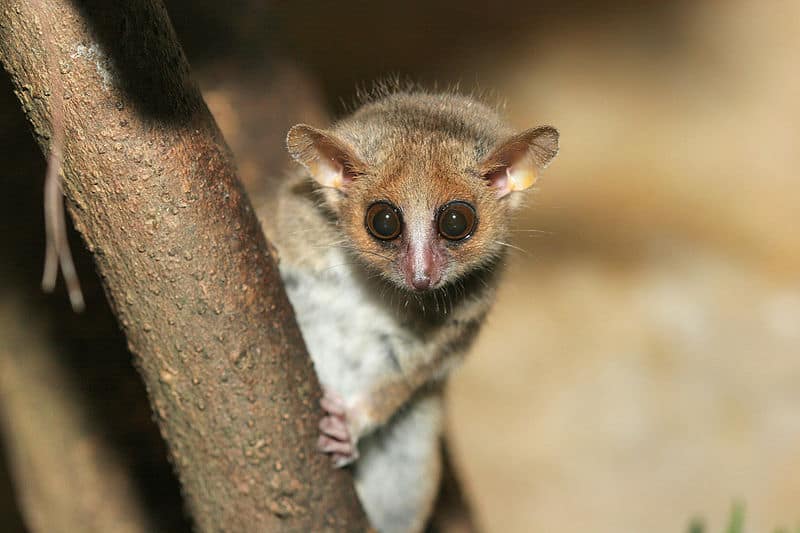Two cuddly-looking primates may have captured your fancy as a child, lemurs vs. monkeys. It’s also possible you didn’t realize that lemurs were different from monkeys. After all, the two general categories of primates appear rather alike in many ways and many of us have just seen them in zoos or in TV or fictional depictions.
These fuzzy critters are characters indeed, with tree living, vocal lives – but what really is the difference between the two? Are lemurs just another type of monkey or are they truly different primates?
Let’s take a look and see what sets these creatures apart from each other.

The fluffy-looking ruffed lemur shows off some vivid coloration.
©J.NATAYO/Shutterstock.com
Lemur Vs. Monkey Quick Overview
| Lemur | Monkey | |
|---|---|---|
| Scientific name | Lemuroidea | Cercopithecidae |
| Description | Monkeys are lesser primates with tails (even if just nubs), narrow-chested bodies, with relatively flat faces and prominent muzzles in most cases. | Known to be docile, gregarious, and family-oriented, lemurs spend most of their lives in trees eating fruits, insects, and other materials, depending on their specialized diets. |
| Habitat and distribution | Endemic only to Madagascar, an island of southern Africa | Monkeys are widely distributed across tropical latitudes of India, Southeast Asia, South America, and Africa. |
| Diet | Specialized diets based on the type of lemur: bamboo for bamboo lemurs, insects and other plant matter for other lemurs | Omnivorous creatures, monkeys eat a wide variety of things including insects, fruit, grasses, leaves, flowers, gums, insect larvae, snails, bird eggs, lizards, small mammals, and small invertebrates. |
| Behavior | Known to be docile, gregarious, and family oriented, lemurs spend most of their lives in trees eating fruits, insects, and other materials, depending on their specialized diets. | Monkeys are strongly social – or anti-social – creatures that form strong bonds with other monkeys as well as bitter rivalries. They’re known to exhibit signs of depression in some cases and great happiness in others. |
Lemur Vs. Monkey: Classification

Monkeys are known as playful creatures, often swinging through the trees and approaching humans with boldness.
©Ludmila Ruzickova/Shutterstock.com
Belonging to the same order of Primates, monkeys and lemurs are both furry mammals with tails (in most cases), furry faces, and high energy levels. Primates are divided into two groupings, Prosimians, which include lorises, tarsiers, and lemurs, and Anthropoids, which include humans, apes, and monkeys. More recent classification has developed dividing these by suborders instead, the Strepsirhini (lorises, lemurs, and bush babies) and Haplorhini (monkeys, apes, and tarsiers).
Lemurs, scientifically known as Lemuroidea, come in about 100 different species. These range in size from the tiny Mouse Lemur to the Indiri, a large lemur the size of many monkeys and even small apes. The name lemur comes from the Latin lemures, which means spirit or ghost. The term was originally used for lorises but eventually became specific to the lemurs of Madagascar.
Monkeys, known scientifically as Cercopithecidae, include a far more diverse group of mammals of the primate family. Included in this group are new world monkeys such as marmosets, spider monkeys, howler monkeys, and tamarins. Also included are old-world monkeys. More than 150 species of animals are classed as monkeys.
Lemur Vs. Monkey: Description

Lemurs also appear playful and energetic, often sticking out their tongues.
©Jearu/Shutterstock.com
Lemurs come in a wide range of sizes from the tiny Madame Berthe’s Mouse lemur that reaches only 3.5 to 4 inches tall, has a 5-inch tail, and weighs only 1 ounce. The Indri lemur, on the other hand, is the largest species of lemur. It measures 24 to 25 inches and weighs as much as 22 pounds.
Lemur coloration varies from species to species, with black and white color forms to gray with ringtail features, bicolor forms, or solids of gray, white, black, brown, or red-brown.
Monkeys also come in many sizes and colors, ranging from the tiny pygmy marmoset at 5 inches and 3.5 ounces to the male mandrill which reaches over 3 feet in height and up to 79 pounds. Monkeys also come in a wide range of colors from brown to red, cream, tan, orange-brown, and many color forms. One unique monkey has a blue face, red tail, white mustache, and yellow cheeks.
Lemur Vs. Monkey Habitat & Distribution

Spider monkeys are avid climbers and live in troops.
©Pakhnyushchy/Shutterstock.com
The only place in the world where you’ll natively find lemurs living is in Madagascar. The island nation of is off the east coast of Africa. The type of terrain in which the lemurs live here varies greatly. They’ve adapted to areas from high mountain ranges to marshlands, lakeside dwellings, semi-deserts, and forests. Some lemurs have exceptionally specialized diets due to their habitats, as well. One example is the bamboo lemur which almost exclusively lives on bamboo, despite the toxic nature of the shoots.
Monkeys, on the other hand, are widely distributed across the planet in tropical environments in Asia, Africa, and Central and South America. Primarily making their homes in tropical rainforests, the various monkey species have also adapted to their environments in unique ways. Some monkeys also dwell in mountains (Geladas and golden monkeys), and the Japanese macaques live in areas of Japan where snow falls. Baboons live in savannas, rocky hillsides, and open woodland areas, as well.
Lemur Vs. Monkey: Diet

Grey Mouse Lemurs eat plant matter, beetles, frogs, and small reptiles.
Lemurs have varied diets, depending on the terrain and size of the species. Often, the smaller lemurs eat mostly fruit and insects, maybe sap. Grey mouse lemurs eat plants, insects, frogs, and small reptiles. Larger lemurs are more likely to be herbivorous, eating plant materials including leaves, flowers, sap, shoots, bark, nectar, and fruits.
Monkeys mostly prefer leaves as their dietary source. Additionally, they’ll eat insects, fruits, grasses, gums, snails, bird eggs, lizards, and small animals.
Lemur Vs. Monkey: Behavior

Graells’s Black-mantle Tamarin are tiny monkeys living in the Andes in Ecuador.
©David Havel/Shutterstock.com
Lemurs
Most lemurs spend their lives in trees feeding, resting, and sleeping, as well as giving birth and raising their young. Some exceptions exist, however, including the ring-tailed lemur which spends much of its life on the ground. Lemurs move about on all fours most of the time, using their pads to “stick” when they jump from one surface to another.
Living in social groups, lemurs have a dominant female as their leader. The leader decides location and movement patterns for the group. Much of the lives of lemurs is spent eating, but between meals and snacks, they like to sunbathe and groom one another. They even use tools for grooming each other, with their elongated nails on the second toes, a grooming claw just for this purpose.
Monkeys
Groups of monkeys are called troops, which travel together in search of food and shelter. A troop may contain a handful of monkeys or a literal thousand plus of the furry primates. Within large troops, harems of much smaller groups will form, including one male and several adult females and their babies. Mutual grooming is used daily to maintain family bonds within these harems.
One exception to the rule is the gray tiki monkey of Bolivia, which lives in small, monogamous family units of parents and immature juveniles.
Monkeys tend to be very active when not traveling along and play for most of their waking hours. This helps young monkeys develop physical and social skills needed later in life. Monkeys are also particularly social animals, which is why the majority live in large social troops.
Both
Vocalization is largely part of both primates’ communication with one another. As highly social animals, they frequently may be heard vocalizing to each other in the wild and in captivity.
The photo featured at the top of this post is ©
Thank you for reading! Have some feedback for us? Contact the AZ Animals editorial team.






